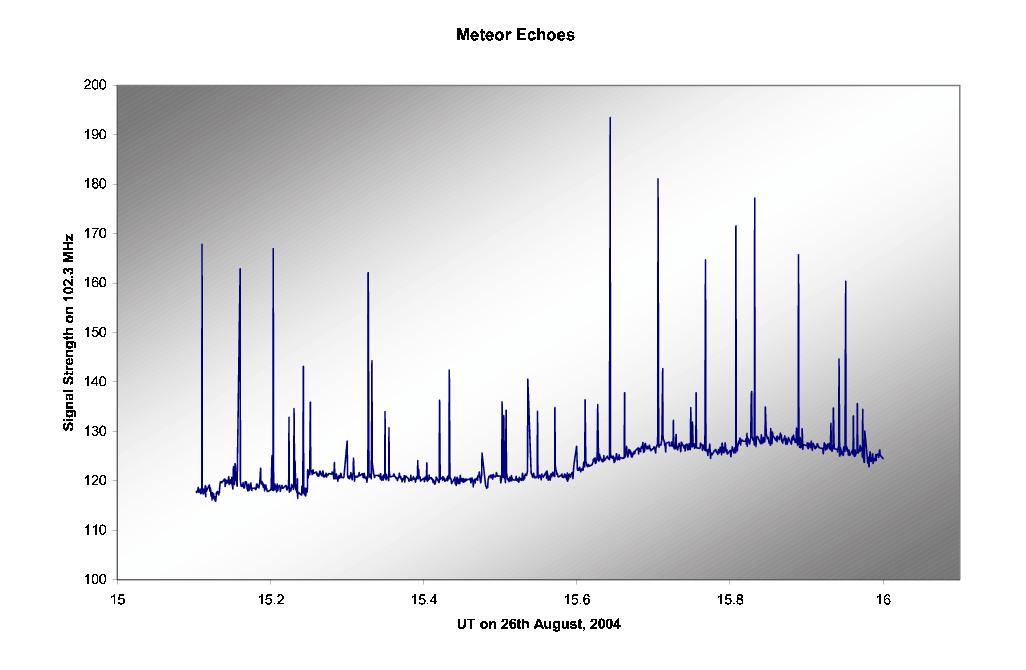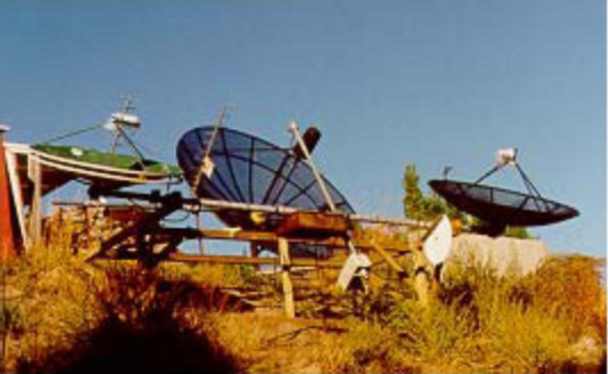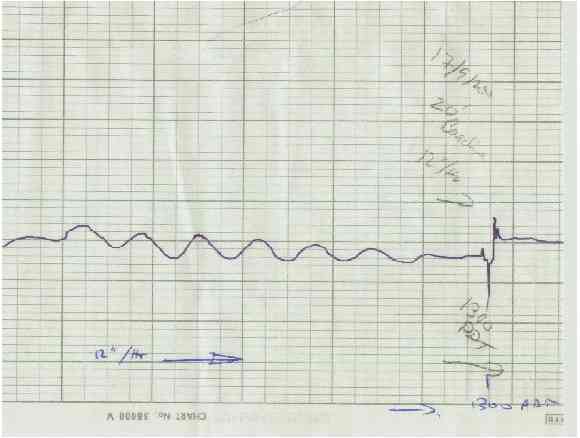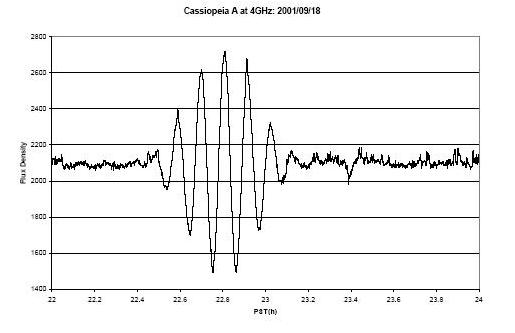
Various documents will be available on UKARANet describing working Amateur Radio Astronomy projects. Some will be in the beginners section. More advanced ones will be in this, the Projects section. These documents will be in PDF or HTML format for online viewing.
Documents available:
Radio Observations of Meteors: the 2004 Perseid Meteor Shower Etc.
Ken Tapping, September 2004
ken.tapping@nrc-cnrc.gc.ca

The record above shows bursts of radio signals reflected from the ionization in meteor trails. The signals come from some FM radio broadcasting stations transmitting at 102.3 MHz, which are too distant to be received by other means. This technique provides a very easy and useful way to count meteors, and has the tremendous advantages of being automatic, and of being unaffected by daylight or cloud.
My introduction to radio observations of meteors was in the early 1970 s. It was during one of my many visits to Ron Ham, an amateur radio astronomer and general radio enthusiast living in Sussex. He had a radio tuned to the frequency of a VHF broadcast transmitter in Gdansk, in Poland, connected to a small Yagi antenna, pointed halfway up the sky, in an northeasterly direction. It was fascinating to listen to the bursts of music or speech, knowing them to come via the ionization trails left by meteors. In addition to detecting the usual meteor showers, he saw the normal diurnal variation in count rate, and also a slight drop in count rate when the Sun was very active. We attributed that to an increase in ionospheric (D-Region) absorption when the solar X-ray flux was higher. A couple of years ago, living at our current address in the Okanagan Valley, in British Columbia, I had an urge to try this for myself. This article describes the hardware, the experiment and discusses observations made of the 2004 Perseid meteor shower.
[VIEW/DOWNLOAD HERE - Format: PDF; 291kB]
Radio Astronomy Experiments at 4 GHz
Ken Tapping, 2003
e-mail address: ken.tapping@nrc-cnrc.gc.ca

Some years ago, someone found they could receive the signals in the 3.7-4.2 GHz Band (C-Band), which is used by broadcasting companies to transfer programme material. This led to a flowering of back garden 10ft and 12ft dishes, mainly in North America, as companies started to sell domestic satellite TV systems to receive this signals. Of course, this free distribution of broadcasts was not what the broadcasting companies intended, and they started to scramble the transmissions. There then followed an arms race between the broadcasters and manufacturers of descramblers . This ended with the introduction of formal broadcasting from satellites, but at a much higher frequency, where domestic satellite receivers only need antennas about 2ft (60cm) or so in diameter.

The C-Band satellite TV market collapsed, leading to relatively state-of-the art receiving equipment becoming available free, or at most, for junk prices. One of the first people to realize that this equipment could be used for a wide range of radio astronomical experiments was Bill Lonc, of St Mary s University, Halifax, Nova Scotia, Canada. In his book Radio Astronomy Projects he describes experiments done with the participation of undergraduate students. These were usually aimed at solar observations, or in a few cases, observations of the Moon. With his assistance, Heather Cameron in Nova Scotia used such systems for single-dish and interferometric observations of the Sun.

For a long time I had no plans to do anything in this frequency range. However, a couple of years ago this changed, thanks to a friend, Tony Zonta, who was (Tony died last year) an avid amateur astronomer. To fund his hobby he ran a pub and small hotel. Tony s pub produces the best pub food in Penticton, and one day, my family and I were enjoying some of this, when Tony joined us. During the conversation he said that he had asked a radio astronomer if one could make a radio telescope out of old C-Band satellite TV equipment, and had been told No . Did I agree with that? I said no. I knew of many examples of radio telescopes having been made out of old satellite TV equipment, Bill Lonc s experiments for example. His reply was There s one on the roof. It s yours!
With a lot of help from Tony, we got the 10ft dish and electronics to our (fortunately) large back garden. Experiments with this led to my getting very interested in the possibilities offered by such cheap but high quality equipment, and led to the series of experiments which are described in this article.
[VIEW/DOWNLOAD HERE - Format: PDF; 1.2MB]
Introduction. Technical progress is bringing the construction of highly sensitive radiotelescopes within the reach of private individuals. Amateur radioastronomers need no longer be limited to making observations of the Sun, Milky Way and the four strongest discrete radio sources. Components, which only a few years ago could be found only in large research facilities, can now be bought over-the-counter. However, building the large antennas and sensitive receivers, and the signal processing needed for some of the more ambitious projects, such as detecting quasars and other faint radio sources, may require the resources of a group. In this paper we summarize the planning and construction of the R. A. S. C. Ottawa Centre's "Indian River Observatory Radio Interferometer". We do not intend it to be a design description, but more an account of the way this project was carried out.
[VIEW/DOWNLOAD HERE - Format: PDF; 688kB]
A Correlation Interferometer for 408 MHz
Ken Tapping, 29 th November, 2001
e-mail address: ken.tapping@nrc.ca
Some Background
One day in the 1980 s I was helping a visiting scientist get his experiment set up at a remote
site to the west of Ottawa. This site contained the decaying remains of decades of radio experiments.
Among some trees I found an old shed, crammed to the roof with yagi antennas, combiners, hybrids
and many matched lengths of heliax coaxial cable. Many were broken, but mixed in with the debris
were some that were intact or not too damaged. They had 14 elements, but were broadband, with a
coupled array of dipoles of varying lengths. They were equipped with bazooka baluns that bore a
label announcing they were designed to work between 400 and 430 MHz. Everything was equipped with
Type N connectors. I managed to get eight yagis into my little Toyota Corolla, along with some
lengths of cable and an assortment of combiners. This led to my plan to make a 408 MHz radio
telescope. The opportunity came several years later, after we had relocated my research programme,
and me, to Penticton, British Columbia.
[VIEW/DOWNLOAD HERE - Format: PDF; 337kB]